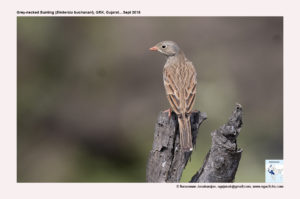
Grey-Neck Bunting Emberiza buchanani
Etymology:
- Emberiza : Old German name Embritz for a bunting
- Buchanani : Named after English zoologist Dr Francis Buchanan (1762–1829)
Vernacular Names: Hindi: Jamjohara, Guj: Patharal gandam, Thoriyo gandam, Mar: Rakhi Manecha Bharit
Distribution in India: Winter visitor in Central and West India.
Description: Size of 15–17 cm; wt. of 17·2–26 g. It is a hooded bunting with rather long pale pinkish bill and prominent whitish eyering. The male of nominate race in breeding plumage has crown to nape, sides of head and neck, malar stripe and side of breast as grey, giving hooded effect. The upperparts are rufous-tinged grey-brown, finely streaked darker brown, scapulars broadly bordered rufous-cinnamon, upperwing similarly rufous-grey with darker feather centres and paler fringes; tail feathers are black, central pair is greyish, outermost pair with extensive white over distal portion of inner webs. The submoustachial stripe, chin and upper throat are whitish, shading to deep cinnamon on breast and remaining underparts, becoming paler on lower underparts. The iris is dark brown with clearly defined narrow white eyering. The bill is very pale pink, yellowish or brownish-yellow, somewhat longer and slimmer. The legs are pinkish-orange. . The male non-breeding is similar to breeding, but all colours subdued by whitish feather fringes and tips, dulling rufous of underparts, but making white of throat and submoustachial stripe cleaner; upperparts appear paler because of wide sandy-grey feather fringes, tail is browner and worn. The female is similar to dullest non-breeding male, but often with some fine streaking on crown and nape, duller pale rufous scapulars and fine streaking across breast. The juvenile plumage is short-lived, similar to female, but nape virtually unstreaked, giving slight contrast with diffusely streaked crown and streaked mantle, scapulars less rufous, and has more extensive rufous and brown streaking on underparts. The first-winter is similar to adult female, but no rufous visible below.
Habitat: It is found in dry, rocky mountainsides, ravines and upland plateaux, with grassy clumps and weedy vegetation; tends to avoid trees, but tolerates broken bushy cover. It breeds chiefly at 900–3200 m. In winter it is found in stony, dry cultivation and dry slopes.
Food habits: It eats wide variety of seeds, and shoots of dry-country plants and various grasses. In breeding season young fed almost entirely with invertebrates, especially both larval and adult stages of weevils and other beetles, grasshoppers , bugs, ants and snails. It forages quietly on ground in pairs and small parties among sparse vegetation; feeds from early morning until 10:00–11:00 hours, before flying to water source, resuming feeding in early evening.
Breeding habits: The males arrive at breeding sites a few days ahead of females. They breed in Apr to Jul in Iran, May in S Turkmenistan, May to Jul in Kazakhstan, May in Afghanistan. The nest is built by female only. The nest is a scrape lined with coarse grass stems, wool and hair, on ground and well hidden under shelter of boulder, grass tuft or small shrub above ground in small shrub. They lay a clutch of 3–6 eggs. The incubation is by female alone, male possibly helps. Both sexes feed young.